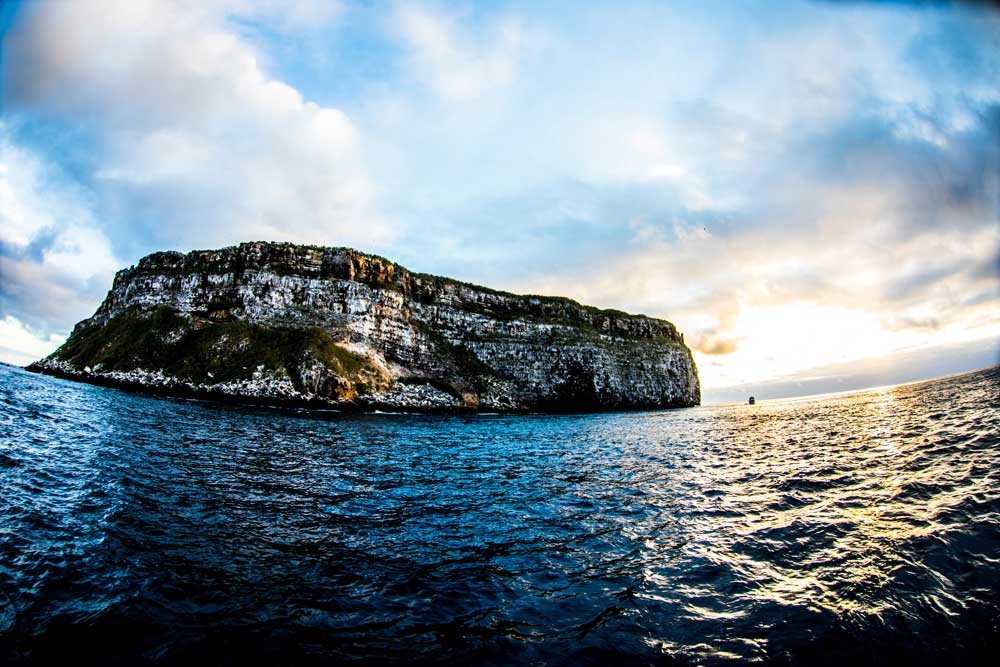
Darwin Island Liveaboard Diving in Galapagos
Darwin Island was named in honor of the renowned naturalist Charles Darwin, who visited the Galapagos in the 1830s. His observations here played a crucial role in the development of the theory of evolution. Despite its significance, Darwin Island remains uninhabited by humans and its shores are largely untouched, offering a pristine environment for divers.
About Darwin Island Liveaboard
Darwin Island offers a unique liveaboard diving experience that every diving enthusiast should have on their bucket list.
When it comes to dive sites, Darwin's Pillars stands out as a premier destination, although unfortunately the pillars now have collapsed. Not only is this site notable for its stunning underwater topography with towering rock pillars, but it's also a hotspot for witnessing the vibrant marine life of the Galapagos liveaboards.
Divers here often report encounters with hammerhead sharks, swirling in vast schools, and the playful dolphins that love to make an appearance. Turtles, manta rays, and large schools of tropical fish paint the waters with color, making every dive feel like a treasure hunt.
Spotting whale sharks and tiger sharks is quite common throughout the season of Darwin Island liveaboard. Dolphins and sea lions are yet another attraction that enchant divers onboard Darwin Island liveaboard.
While the beauty beneath the waves is undeniable, divers should come prepared for varying water temperatures. Throughout the year, water temperatures at Darwin Island can range from a cool 60°F (15°C) to a warmer 82°F (28°C). This variance is mainly influenced by the cold Cromwell Current from the west meeting the warmer Panama Current from the north. As such, divers should ensure they pack both thin tropical and thicker wetsuits to stay comfortable during their dives.
Typically liveaboards in Galapagos that visit Darwin Island will also stop at Wolf Island and at night retreating for safe harbor there. Wolf Island is located approximately 40 km (25 miles) from Darwin Island.
When To Go to Darwin Island?
For those wondering when the best time to embark on a Darwin Island liveaboard diving adventure is, the answer largely depends on what you're hoping to see.
From June to November, the cooler water temperatures draw in a plethora of hammerhead sharks and whale sharks, making it the best time for those who are eager to witness these majestic creatures up close.
However, December to May boasts clearer waters, calmer seas, and warmer temperatures, making dives more comfortable and visibility optimal.
Tips For Travellers
Ensure you are well-versed in strong current diving. Due to its location, Darwin Island often experiences stronger currents which can challenge even the most experienced divers.
Buddy system is more important than ever as the currents can prove to be challenging. Do not venture alone, listen to the briefing and follow your dive guide.
Internet connection or cell phone coverage is limited across Galapagos so be prepared to be disconnected for several days in a row.
Check the minimum diving experience as some dive sites require advanced certification or a specific number of logged dives to be able to enjoy.
How to get there & Ports of Departure?
All international travelers will first land in mainland Ecuador, typically in cities like Quito or Guayaquil. From here, you'll catch a domestic flight to the Galapagos. There are two main airports in the Galapagos: Seymour Airport on Baltra Island and San Cristobal Airport on San Cristobal Island. Most liveaboard operators will specify which airport to fly into based on their starting point.
Ensure you have a valid passport. Although some countries may have specific visa requirements, most tourists can stay in Ecuador for up to 90 days without a visa.
Before boarding your flight to the Galapagos, you'll need to purchase a Transit Control Card (TCC), which helps regulate and record the number of visitors to the islands. It's a small fee, and it's essential to keep this card safe as you'll need it for your return journey.
Essential Travel Tips for Liveaboard Adventures
- Marine Park Fees: Be aware of per person, per day marine park fees. Some liveaboard packages include these fees, while others require onboard payment. Payment options include Visa, Mastercard, cash, or travelers checks.
- Passport Validity: Ensure your passport is valid for at least 6 months after your planned entry date. Most countries require this, along with a return ticket. Check visa requirements in advance.
- Health Preparations: Consult your doctor 8 weeks prior to your trip for vaccinations or preventive measures recommended for your destination.
Note: Please review the specific terms and conditions of your chosen liveaboard for any additional marine park fees or travel requirements.
We're Here to Help 24/7






